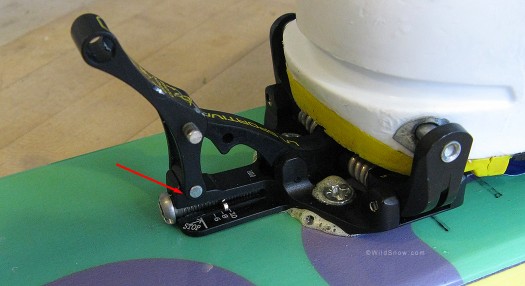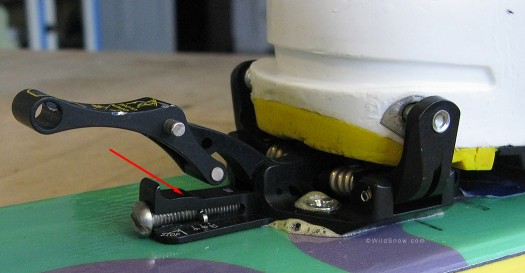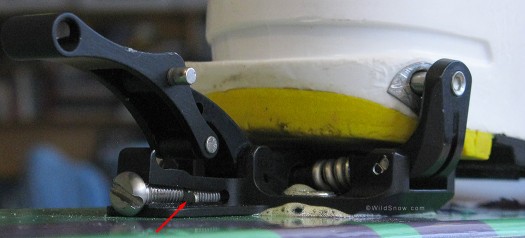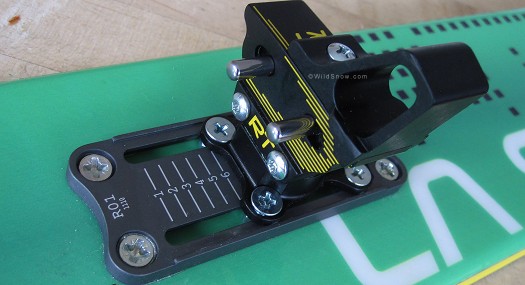
ATK La Sportiva Binding pan
The La Sportiva branded ATK binding that is now fairly well distributed and giving other tech bindings at least a bit of run. The binding is nearly 100% aluminum and relatively un-tested by heavy consumer use. Thus, while we appreciate the engineering and workmanship of this grabber, the jury is out on real-world performance. We’ve used the binding for around 6 days and have had no issues, and look forward to reports from early adopters with more days. Mouse over to pan image above, and click on images below to enlarge. I guess I’m pano mad these days!
In what is obviously an effort to create a “vertical” line of backcountry skiing products, La Sportiva is distributing a version of ATK RT bindings as the “La Sportiva RT.” The PR folks have asked us to subsequently refer to the binding as the “La Sportiva.” Why not, perhaps they’ll buy me an espresso? So we’ll use the requested nomenclature, only I’ll shorten the noun to “Sportiva” or “Sportiva RT” for help with my carpel tunnels.
Not only is the Sportiva binding super lightweight (8 ounces per ski, with screws and without brake), but it provides a signature feature in that you can adjust holding tension of the LOCKED toe. In other words, when the binding is being used with the touring release lock-out engaged you can select a range of “strength” for the lock.

La Sportiva tech binding lock system engaged. Tension while locked is adjusted by turning the obvious screw, which in turn raises and lowers the arrow indicated landing. The landing is engaged by the base of the touring lock cam lever. Important to note this adjustment makes zero change to release values (while touring or downhill skiing) when the lock is NOT engaged.
Important: This adjustable touring lock tension has NOTHING to do with lateral release when the binding is unlocked and in full safety-binding downhill mode — it only has an effect when the binding is locked for walking and climbing while backcountry skiing, as it works by changing the camming tension of the lock lever (mostly for the purpose of absorbing variations in manufacturing tolerances).
This pops the bubble of some folks on the net proclaiming that the Sportiva has an “adjustable release at the toe.” While perhaps this is so if you’re skiing downhill with the toe locked and want lateral release settings in the 13+ range, for most people it simply means you can adjust how tight the toe locks while you are touring — useful for larger folks, or individuals who want to tune their binding so it’ll come off in situations such as an avalanche entrainment while they’re in touring mode, but stay on their feet during normal uphill use.

Sportiva binding, touring lock not engaged. Obvious screw raises and lowers the landing indicated by arrow. Numbers have no relationship to DIN calibrated release values, they're just for reference.
To clarify. In my hand-testing on the bench, it was obvious that when the Sportiva binding was set in downhill mode (heel locked down), with the touring lock in engaged position, lateral release value was easily up in the range of 12 or more with the touring lock tension dialed as low as possible. (Bear in mind the tech binding locks do not change or lock upward ‘vertical’ release). Upon setting the lock tension higher, the difference in lateral release resistance was easy to feel, and I’d guess reached the RV 16 or greater range. In all cases, with the lock engaged the binding lacked full lateral elasticity and the boot tended to load up with a ton of torque before violently popping to the side out of the binding. Obviously, this sort of behavior is not going to save your knee ligaments unless you share DNA with Hulk. Thus, as with other tech bindings for most skiers, when the Sportiva is locked, it is simply LOCKED (in terms of lateral release).
Whew. With the above mythology straightened out, let us move along.
More toe info: Verified by bench testing, the tech pins are properly sized for a nice smooth lateral release when using boots with good quality tech fittings. The toe is mounted with 4 screws on same pattern as most other tech bindings. Crampon holder is part of binding base and compatible with any crampon that works with other tech bindings. That said, if your crampons are much wider than your skis and thus subject to much torque, we wonder how well the tiny aluminum crampon hooks on the Sportiva binding would hold up. Whatever, if one of these breaks the day can go on. The toe does not use a base plate. Very simple. Very light.

Another view of touring lock, small metal piece indicated by arrow moves for and aft to raise and lower the lock landing, by virtue of the tapered slot it rides in. Very simple.
Heel unit
Sportiva heel unit is sold with a base plate that allows boot length range of 3 centimeters. For less weight (and less ramp angle) you can mount the binding heel without the adjustment plate (Doing so is tricky; with no for/aft adjustment things have to be perfect). The infamous tech binding “gap” between binding and heel is set using the for/aft adjustment, and appeared to me to be best at 5.5 mm.

Heel unit with base plate. For aft adjustment is done by loosening the obvious philips screws and sliding the top part. For a race type configuration and weight savings, the heel can be mounted without the base.
Regarding the high heel lifter. Unless you’ve got just the right sized ski pole tips, you’ll have no luck rotating the heel unit with a pole. Even if you can insert a pole tip in the lifter, you’ll find that in certain positions doing so is excessively awkward, leading to our conclusion that the Sportiva is designed to be rotated by reaching down and doing it with your hands. That’s probably fine in Europe, where most skin tracks are optimized for medium lift on tech binding. But here in North America we tend to have skin tracks that vary frequently from medium lift to sections requiring high lift (apparently due to young, testosterone poisoned trail breakers who prefer to make climbs as tough as possible). Constantly reaching down to set the binding for such tracks can quickly reach the tedium of flipping burgers for a living, only more strenuous. Likewise, if you’ve wired a system for quick mode changes that involves using your pole to rotate your tech binding heel, you’ll probably find that’s not ideal with the Sportiva and you’ll be back to doing it by hand.
And yes, the binding can be configured without the high-lift on the heel unit, so it’s totally in race mode. An add-on ski brake is available, we did not test.
Our conclusion: Noticeable weight savings with this nearly all alu offering. Toe tension adjustment could be useful for larger skiers who have trouble staying in tech bindings in touring mode with toe locked, but makes NO difference in release value in alpine mode with toe unlocked. We question strength of aluminum toe wings. Consumer testing will tell the tale. I skied on the binding for six up/down tests for a total of about 13,000 vertical of uphill, and it skied and functioned in similar fashion to most other tech bindings, albeit with the more difficult to operate heel lifter. If you want to be an early adopter, here is a La Sportiva RT shopping link for your card melting pleasure!
La Sportiva RT binding weights:
Total binding with screws, no brake, 8 ounces, 226 gr.
Toe unit, no screws, 3 ounces, 88 gr.
Heel unit, no screws, 4.3 ounces, 122 gr.
WildSnow.com publisher emeritus and founder Lou (Louis Dawson) has a 50+ years career in climbing, backcountry skiing and ski mountaineering. He was the first person in history to ski down all 54 Colorado 14,000-foot peaks, has authored numerous books about about backcountry skiing, and has skied from the summit of Denali in Alaska, North America’s highest mountain.
